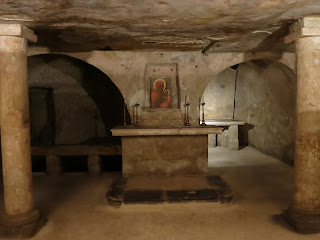Last night, once we got settled into the Casa Amalfitana, we took our cameras and walked around the streets of the Old Town. The nearby Plaza contained several cafes and restaurants, and as seems to be the norm here in Italy, people were out strolling - this time till almost midnight - and it was a school night so not many school kids out.
The picture you see here was taken just outside our flat's doorway looking up the street (really a lane since no cars could fit between the walls) towards the Cathedral - a 2 minute walk.
It was raining when we woke this morning but we weren't going to let a little rain stop us. While fixing breakfast and waiting for the water to boil (no coffee-maker here, just instant) I took a closer look at our limestone walls.
Most buildings in this part of Italy are built using this soft rock which is composed of skeletal fragments of marine organisms and I was able to find fossil imprints and entire sea shells embedded in our walls ! After we ate breakfast, we put on our raincoats and headed out - dodging thunderstorms all day - it was off and on with the raincoats.
MONOPOLI
Monopoli is a nice and fascinating town on the Adriatic Coast of the Apulia region, on the sea. The area was first settled as a Greek establishment as the city of Gnatia.
After the destruction of Gnatia by the Ostrogoth King Totila in 545, its inhabitants fled to Monopoli, from which it derives its name as ‘only city’. In the following centuries the area would be controlled by the Byzantines, Normans and Hohenstaufen, and was a starting point for the naval Crusades’ expeditions. Later Monopoli was a fiefdom under Aragonese feudal lords. In 1484 the city came under Venetian control and saw an economic upswing as a seaport on the Adriatic Sea serving as a base between the Italian cities of Bari and Brindisi, as well as through trading its own agricultural goods. Monopoli was frequently attacked by Muslim pirates in the following decades. Under Spanish rule Monopoli became a free city in 1545 and became part of the newly-unified Kingdom of Italy in 1860.
As is typical with most Pugliese towns and cities the modern part of the town is unremarkable but once you enter the Centro Storico, it is like entering a new world - obviously, the Old World ! Of course the buildings are old, but they are well maintained and one of the nicest historic centers that we visited.
BASILICA CATHEDRALE MARIA SANTISIMA DELLA MADIA

 The Cathedral was magnificent, inside and out. The original Church was begun in 1107, on what had been a Roman Temple and burial site, but was not finished until after 1117.
The Cathedral was magnificent, inside and out. The original Church was begun in 1107, on what had been a Roman Temple and burial site, but was not finished until after 1117.Perhaps the greatest date in the city’s history was 16 December 1117. It was during the night that an image of the Madonna della Madia floated into the port together with sturdy beams which were subsequently used to repair the sorry roof of the Cathedral.
Outside the Church, the Baroque bell tower soars up over the town, and like a beacon, appears on the horizon as it has done for centuries.
THE CASTLE
The Castle of Charles V was finished in 1525, and was built in the shape of a pentagon. In the spot where the castle now stands, traces of village huts dating back to the Bronze Age have been found. The castle is located on a promontory which was originally separated from the medieval city, and was built on the remains of a Norman castle. It was restored and enlarged in the 17th century.
Starting in the early 19th century, it was used as a jail, which continued up until 1969. The castle is currently being used for art exhibitions and cultural events. Inside, was a replica of what the city would have looked like in the 1600's, and we were easily able to pick out the building where we are staying !
The Cathedral and the Castle are only open for a few hours every day, and we were fortunate that we were able to go inside both of them.
SANTA MARIA DI AMALFITANA
Across from the corner of our medieval building where we are staying in the flat is an old church, which Tom had noticed would be open to visitors late this afternoon. The guide led us downstairs to the crypt which had been carved inside a wide cave. According to tradition, in 1059 during the 11th century, a group of sailors from Amalfi who survived a shipwreck, stopped to pray to thank Holy Mary, inside this cave, which was already a Greek Orthodox place of worship.
There have been numerous burials in the crypt, and much of the ceiling had been decorated with frescoes. Some families from the Republic of Amalfi erected the upper church in the 12th century, and named it after St. Mary. The side walls of the church were damaged in the 1930's, but it has undergone restoration, and is still regularly used for Masses, weddings, and music concerts.
Tomorrow brings our getaway day from the Italian Adriatic Coast back to Rome in preparation for our return to South Carolina on Friday. It is about a five (5) hour drive and we will be cutting across the heartland of Italy through some of its National Parks - hope there is some good scenery for us and hopefully no bad weather.











No comments:
Post a Comment